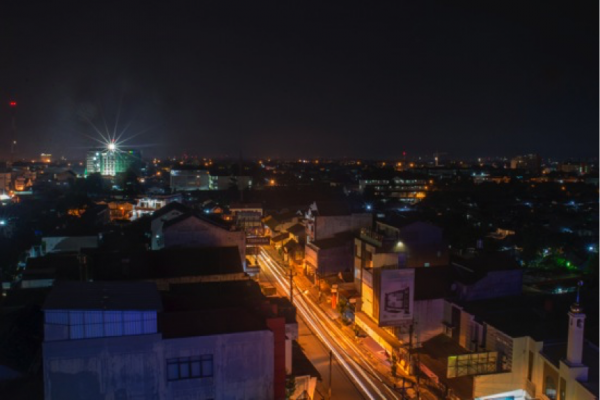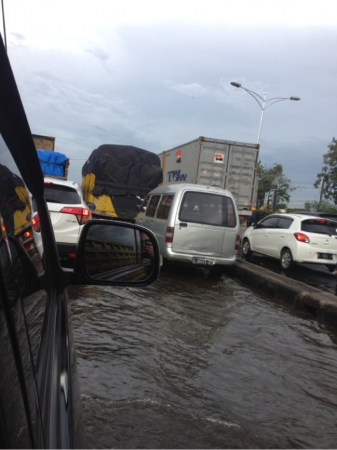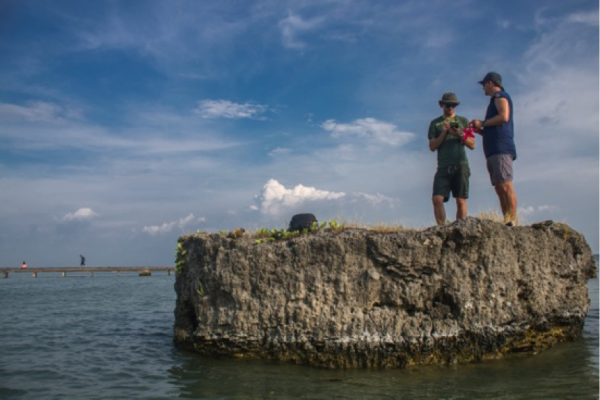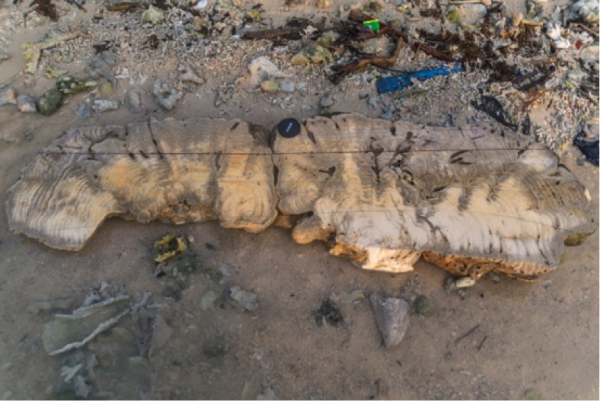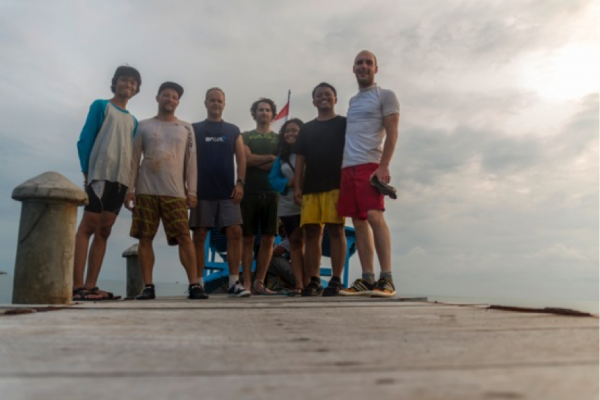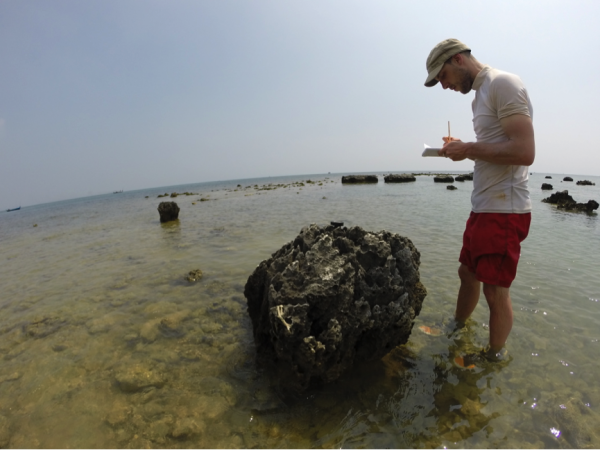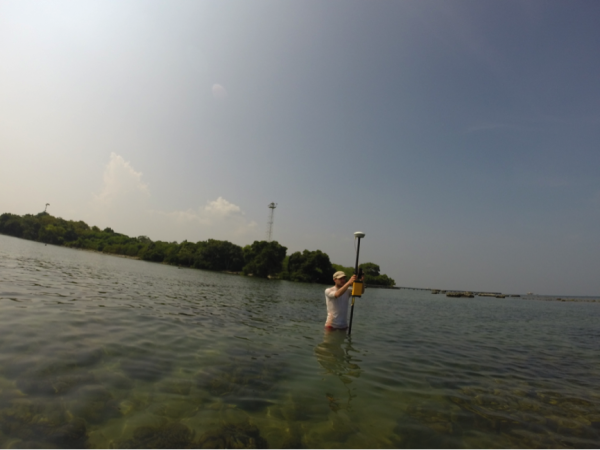Yogyakarta by night | Photo: Thomas Mann
Holocene sea-level data are used to tune global model predictions for future sea-level change. In Indonesia, the largest island state in the world, such data are in the best case scarce. During a reconnaissance trip to Semarang at the north coast of Java last year in September, I discovered an extensive field of raised microatolls on the reef flat of a nearby island. Microatolls are coral colonies that often have a flat top and annular perimeter due to exposure during low tide. This relationship between morphology and low-water
level makes them especially valuable as sea-level indicators in the present but also for the geological past. In order to improve our understanding of Holocene sea-level variability, climate-controlled or tectonically induced, and to inform predictions of future sea-level change for the southeast Asian region, my team and I have been heading off to Semarang where sea-level changes can be inferred from some massive and well-preserved fossil microatolls.
19.5.-24.5.
After my return from Semarang in the evening of 18 May, we continued with the fieldwork. In total we sampled ten fossil microatolls that appear to be in-situ, i.e. do not look reworked due to storm waves. Furthermore, we surveyed the reef flat along several transects in order to get some information about the geomorphology. We also continued slabbing some other promising specimens which will allow us to reconstruct growth histories of coeval populations of microatolls and may help us to decipher tectonic from climatic influences. Last but not least, we surveyed living microatolls as the modern equivalents to our fossil friends and sampled some reworked coral boulders to get an idea if these yield different ages as those that appear in-situ.
21 May was our last day in the field. We were lucky to finish with the GPS work right on time before a heavy rain period started which would have made a continuation of the survey impossible. However, all the loggers for tides and barometric pressure still had to be collected and we have been busy until late in the evening to construct tailor-made wooden boxes for the microatoll slabs in order to bring them back home safely.
Eddie´s return flight to NZ was scheduled for 22 May and we went back to Semarang altogether. After Eddie´s departure, Dominik and I continued with the preparation of the samples for shipping. At the end of the day, we had 5 boxes totaling 70 kg of plugs and slabs from different fossil microatolls. On the 23 May, I could pick up my passport at the immigration office in Semarang and prepared all the lists and letters for the sample boxes.
24 May, Dominik returned to Makassar in the morning. My flight was scheduled for 3:30 PM but I arrived at the airport much earlier in case of any problems that may had occurred because of the samples. Yet, in Semarang it was a very smooth process. However, due to the additional luggage, I had to pick everything up in Jakarta and check in again.
The microatolls look good in x-ray images. I know because the security guy in Soekarno-Hatta showed it to me connected with the emphasized question what that is. The atmosphere was tense in that moment but the airport staff have been very professional. I explained them what it is and showed them the material export and research permits. This was enough to make them smile again (and me too…) and I could continue with the samples without unscrewing the boxes.
And this is the end. The samples are now at ZMT and wait for being further analyzed. In summary, I can say that this was one of the most intense fieldtrips I have ever experienced. But with the great support of Paul, Eddie, Dominik and our students it appears to be also a very successful one.
13.5.-18.5.
In the morning of the 13 May, I went to the local immigration office in Semarang to obtain my limited stay permit as well as my exit permit. I was joined by Dr. Dominik Kneer from the AWI in Bremerhaven. Dominik lives in Makassar, Sulawesi, and we met last year for the first time. We share some research interests and he kindly agreed to join me on my visit to the immigration office as well as to support me during the fieldwork. The procedures at the immigration office did not take us too long so we had time to drive to the city center and watch out for our research equipment, i.e. mainly saws in every conceivable size as well as some other tools and hardware.
In the afternoon, the team got completed when Prof. Dr. Paul Kench and Eddie Beetham, both from the School of Environment at the University of Auckland, arrived in Semarang. On the next day, 14 May, we all met with Mr. Helmi who is lecturer at the University Diponegoro in Semarang. I know Mr. Helmi from my last stay in Semarang and it was a great pleasure to see him again. He brought three students with him, Ratu, Azam and Tree who join us in the field. All three of them are very smart and polite and I hope we will be able to teach them some basic aspects of sea-level change and geological methods to detect these.
After our meeting we went back to the hardware quarter of Semarang and bought all the research equipment we needed. In the afternoon we were then able to drive to the study site which is about 60 km northeast of Semarang. Usually that ride takes about 2h, however due to flooding in Semarang one lane of the road was closed and it took us 4h to arrive there.
8.5.-12.5.
Every research trip to Indonesia starts usually with the administrative processes in order to obtain the research permit. I arrived in Jakarta on 9 May in the evening and went to RISTEK, the Indonesian Research Authority, and some other authorities for the necessary reports. These steps have been largely completed until the 11 May which gave me the opportunity to follow the invitation of our local counterpart, Prof. Dr. Marfai, and to fly to Yogyakarta for a Seminar on Coastal and Watershed Management. My talk was entitled “Holocene sea-level variability in Indonesia” and I presented some of the work I have been doing in the Spermonde Archipelago during my PhD, and also an outlook on the work that will follow in Semarang.
From all the cities I have been so far in Indonesia, Yogya belongs certainly to my favorite ones. The traffic is by far not as busy as, for example, in Jakarta, the architecture is in places really beautiful and the surrounding nature and cultural heritage are breathtaking. Unfortunately I was very busy and had no time to stay very long. I was also keen to go back to the study site, and so I left Yogya already one day after my arrival to fly to Semarang.
From the 15-17 May we spent the whole time in the field. We surveyed, sampled and slabbed a number of fossil microatolls and discussed about the genesis of the different generations of microatoll populations that occur on the reef flat. It is a great experience and joy to collaborate with some of the leading experts in the field.
On 18 May, Paul had to leave Indonesia again and went back to Auckland due to some other duties. I joined him on the way to Semarang as I had also another appointment at the immigration office. According to their schedule, my passport is ready to get picked up on Monday next week, which is the day before my departure….Hope it works out, timing is everything in Indonesia.
Thomas Mann, WG Geoecology and Carbonate Sedimentology





